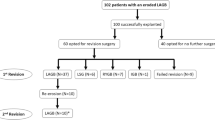Abstract
Background
Intragastric erosion is a rare but major complication of laparoscopic adjustable gastric band (LAGB) surgery for morbid obesity. Many techniques to treat this problem have been described, with little supporting evidence. The authors review their experience with laparoscopic removal of eroded gastric bands.
Methods
The prospectively collected bariatric surgery database of the authors’ practice was queried for the period January 2000 until February 2011, and the medical records for all patients with the diagnosis of band erosion were reviewed. Symptoms, time to erosion, interval between diagnosis and treatment, and complications of treatment were reviewed. All patients had undergone laparoscopy, cut-down onto the band, unclasping or division of the band near the buckle, removal of the band, and primary closure of the gastrotomy with omental patch reinforcement.
Results
During the study period, 2,097 LAGB operations were performed and 53 (2.53%) of these resulted in intragastric erosion. All the bands placed were LapBands (Allergan, Inc., Irvine, CA, USA). Erosions occurred with 14 of the 10-cm bands, 11 of the Vanguard bands, 14 of the AP Small bands, and 14 of the AP Large bands. Three patients elected to have their revisional surgery elsewhere and thus were lost to follow-up evaluation. One patient declined to have her band removed. The remaining 49 patients were included in the analysis. The mean time from band placement to the diagnosis of erosion was 31.5 months, and the mean time from diagnosis to band removal was 32 days. The mean hospital stay was 4 days. The complications included one postoperative leak, four superficial wound infections, and one pleural effusion. There were no deaths.
Conclusions
This review demonstrates the safety of laparoscopic removal of eroded gastric bands with primary closure and omental patch repair. The time from diagnosis of erosion to treatment can be short, in contrast to endoscopic removal, in which the requirement for further erosion of the band to free the buckle often necessitates delayed treatment.



Similar content being viewed by others
References
Kohn GP, Galanko JA, Overby DW, Farrell TM (2009) Recent trends in bariatric surgery case volume in the United States. Surgery 146:375–380
Medicare Australia (2011) Medicare Australia statistics. Australian Government. http://www.budget.gov.au/. Accessed on 1 April 2011
Niville E, Dams A, Vlasselaers J (2001) Lap-Band erosion: incidence and treatment. Obes Surg 11:744–747
Meir E, Van Baden M (1999) Adjustable silicone gastric banding and band erosion: personal experience and hypotheses. Obes Surg 9:191–193
Lattuada E, Zappa MA, Mozzi E, Fichera G, Granelli P, De Ruberto F, Antonini I, Radaelli S, Roviaro G (2007) Band erosion following gastric banding: how to treat it. Obes Surg 17:329–333
Cherian PT, Goussous G, Ashori F, Sigurdsson A (2010) Band erosion after laparoscopic gastric banding: a retrospective analysis of 865 patients over 5 years. Surg Endosc 24:2031–2038
Basa NR, Dutson E, Lewis C, Derezin M, Han S, Mehran A (2008) Laparoscopic transgastric removal of eroded adjustable band: a novel approach. Surg Obes Relat Dis 4:194–197
Neto MP, Ramos AC, Campos JM, Murakami AH, Falcao M, Moura EH, Evangelista LF, Escalona A, Zundel N (2010) Endoscopic removal of eroded adjustable gastric band: lessons learned after 5 years and 78 cases. Surg Obes Relat Dis 6:423–427
Blero D, Eisendrath P, Vandermeeren A, Closset J, Mehdi A, Le OM, Deviere J (2010) Endoscopic removal of dysfunctioning bands or rings after restrictive bariatric procedures. Gastrointest Endosc 71:468–474
Kurian M, Sultan S, Garg K, Youn H, Fielding G, Ren-Fielding C (2010) Evaluating gastric erosion in band management: an algorithm for stratification of risk. Surg Obes Relat Dis 6:386–389
Silecchia G, Restuccia A, Elmore U, Polito D, Perrotta N, Genco A, Bacci V, Basso N (2001) Laparoscopic adjustable silicone gastric banding: prospective evaluation of intragastric migration of the lap-band. Surg Laparosc Endosc Percutan Tech 11:229–234
Westling A, Bjurling K, Ohrvall M, Gustavsson S (1998) Silicone-adjustable gastric banding: disappointing results. Obes Surg 8:467–474
Dixon JB, O’Brien PE (2005) Permeability of the silicone membrane in laparoscopic adjustable gastric bands has important clinical implications. Obes Surg 15:624–629
Abu-Abeid S, Szold A (2001) Laparoscopic management of Lap-Band erosion. Obes Surg 11:87–89
Disclosures
Geoffrey Paul Kohn, Cheryl Anne Hansen, Richard William Gilhome, Ray Charles McHenry, Dean Constantine Spilias, and Chris Hensman have no conflicts of interest or financial ties to disclose.
Author information
Authors and Affiliations
Corresponding author
Rights and permissions
About this article
Cite this article
Kohn, G.P., Hansen, C.A., Gilhome, R.W. et al. Laparoscopic management of gastric band erosions: a 10-year series of 49 cases. Surg Endosc 26, 541–545 (2012). https://doi.org/10.1007/s00464-011-1916-6
Received:
Accepted:
Published:
Issue Date:
DOI: https://doi.org/10.1007/s00464-011-1916-6




